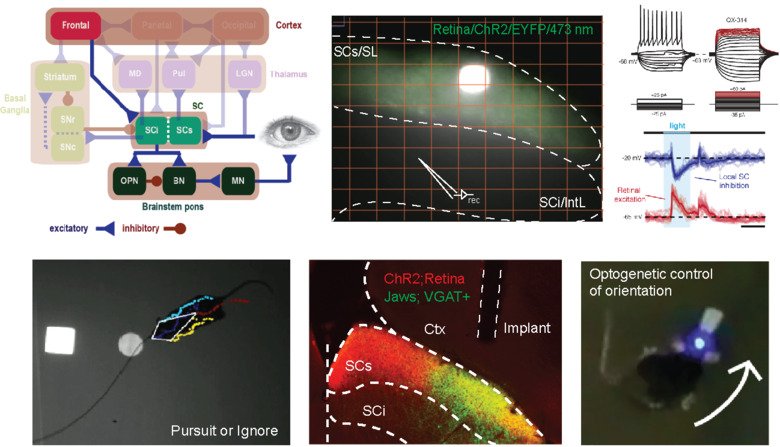Team Kardamakis
How the nervous system achieves versatility in visuospatial behaviour is a fundamental, yet unresolved, question in neuroscience that requires a cross-disciplinary approach. Our group addresses this question in the context of neural circuits controlling visual-based orienting behaviour.
Research focus
Mammalian visuomotor circuit laboratory
Orienting or 'paying attention' to visual events in our surroundings while ignoring irrelevant ones during various tasks highlights a main feature of selective visual attention, which aims to rapidly and accurately solve this dimensionality reduction and context-dependent classification problem.
One of our main research objectives is to obtain a mechanistic understanding of how neural circuits implement this computation by linking patterned visual input onto selected motor behaviour at: (A) the level of the individual neuron and (B) their synaptic interactions within visuomotor loops involving the retina, superior colliculus, frontocortical networks and substantia nigra. Our expertise lies in microcircuit and systems approaches that involve a combination of electrophysiology, optogenetics, viral-based approaches, behaviour and computation.
From a neurobiological perspective, we anticipate our projects will yield results that will update our current views on the processes involved in the versatile control of visuospatial behaviour by unravelling key principles linking vision to action. Understanding the mode of communication between cortical and subcortical areas may also lead to the development of brain-machine interfaces for the manipulation of midbrain activity for restoring visuomotor function in affected individuals.
From a algorithmic perspective, our experiments are designed to test several hypotheses that will also advance our knowledge on the computational principles underlying visual search behaviour, thereby, inspiring the creation of brain-like heuristic and learning approaches to real-world applications, such as machine vision and robotics.
Research associates
- Wilhelm Thunberg
- Teresa Femenia Canto
Research Support
- Hedlunds Stiftelse
- Karolinska Institutet
- Olle Engqvist Foundation
- Strategic Neuroscience (StratNeuro)
- Swedish Brain Foundation
- Swedish Research Council
Grants
- Swedish Research Council Project Grant 2021-2023
- Stiftelsen Kronprinsessan Margaretas Arbetsfond för synskadade 2020
- Stiftelsen Kronprinsessan Margaretas Arbetsfond för synskadade 2019
Publications
Flowing from sense to action. Are neural integrators necessary?
Kardamakis AA
J. Physiol. (Lond.) 2018 Dec;596(24):6131-6132
Direct Dopaminergic Projections from the SNc Modulate Visuomotor Transformation in the Lamprey Tectum.
Pérez-Fernández J, Kardamakis AA, Suzuki DG, Robertson B, Grillner S
Neuron 2017 Nov;96(4):910-924.e5
Spatiotemporal interplay between multisensory excitation and recruited inhibition in the lamprey optic tectum.
Kardamakis AA, Pérez-Fernández J, Grillner S
Elife 2016 09;5():
Tectal microcircuit generating visual selection commands on gaze-controlling neurons.
Kardamakis AA, Saitoh K, Grillner S
Proc. Natl. Acad. Sci. U.S.A. 2015 Apr;112(15):E1956-65
Neural network simulations of the primate oculomotor system. V. Eye-head gaze shifts.
Kardamakis AA, Grantyn A, Moschovakis AK
Biol Cybern 2010 Mar;102(3):209-25
Optimal control of gaze shifts.
Kardamakis A, Moschovakis A
J Neurosci, 29(24); 7723-30
Implications of interrupted eye-head gaze shifts for resettable integrator reset.
Kardamakis AA, Moschovakis AK
Brain Res. Bull. 2006 Jun;70(2):171-8

